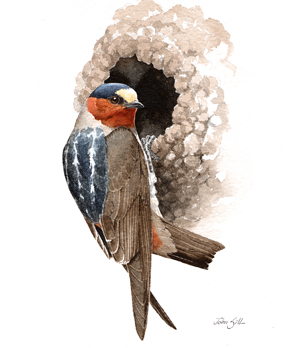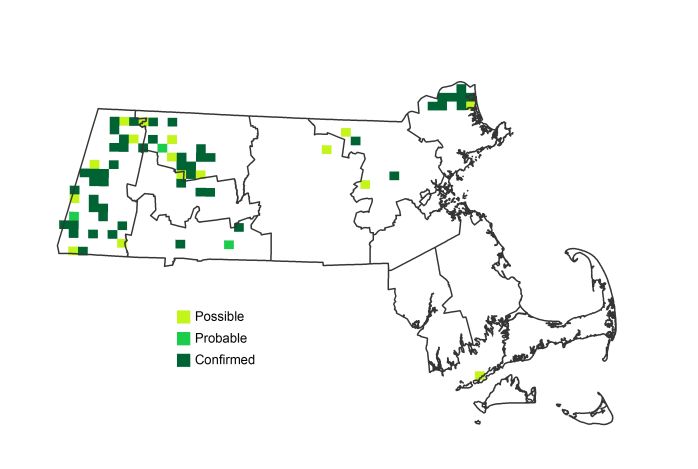Find a Bird
Cliff Swallow
Petrochelidon pyrrhonota

Local and strongly declining
Conservation action urgent

“When the swallows come back to Capistrano, / That's the day you promised to come back to me” – Leon René, “When the Swallows Come Back to Capistrano”
The Cliff Swallow is the species immortalized in Leon René’s famous song, but in addition to nesting in the arid Southwest it also breeds right here in Massachusetts. In recent years the swallows have failed to return to Mission San Juan Capistrano, and their numbers in Massachusetts are dwindling as well. A highly colonial species, Cliff Swallows have clusters of nests that are typically constructed in corners, with wall behind and ceiling above. A lack of appropriate nesting places and serious pressure from invasive species such as House Sparrows are threatening to push Cliff Swallows over the edge in many areas.
Historic Status
As European settlement spread west, Cliff Swallows moved east. In the early part of the 1800s, most Massachusetts residents could not lay claim to knowing what a Cliff Swallow was. By 1839, however, they had become populous in the western half of the state and were still moving eastward (Peabody 1839). At first strictly cliff dwellers, the swallows found suitable nesting habitat under the eaves of homes and on the undersides of bridges that were being built in many areas all across the United States; accordingly, they became known colloquially as “Eaves Swallows.” Seemingly as soon as they arrived, they were forced out by the introduced House Sparrow, which won the completion with the swallows for nesting sites in Massachusetts (Forbush 1929). Other factors, from the whims of architectural trends to pesticide usage, increasingly made Cliff Swallow sightings notably rarer in Massachusetts than they had been in the mid-1800s (Petersen & Meservey 2003).
Atlas 1 Distribution
Cliff Swallows in Atlas 1 were often excluded from otherwise suitable habitat by the presence of House Sparrows. The mountainous western areas of the state hosted fair numbers of Cliff Swallow colonies, both on natural cliffs and human structures such as barns and bridges. The Connecticut River Valley had no shortage of such structures but had only 21% occupancy, likely due to heavy infiltration of House Sparrows and the increased use of agricultural pesticides. Swallows were present in similar proportions across the Worcester and Lower Worcester Plateau regions, but Coastal Plains records were almost entirely restricted to the northern parts of the region. Only a handful of Cliff Swallow colonies were reported in the Lowlands and Cape Cod.
Atlas 2 Distribution and Change
The small numbers found in the southeastern parts of the state all but vanished between Atlas projects, and no Cliff Swallows were found in Norfolk, Bristol, Plymouth, Barnstable, and Nantucket Counties. The only sighting south and east of Boston was on the Elizabeth Islands chain. The species entirely vacated the Worcester Plateau as well. The Cliff Swallows that were found in Massachusetts during Atlas 2—with less than half the breeding footprint of Atlas 1—were largely located in the west, where suitable nesting sites (i.e., old barns) could still be found, along with a few in northern Essex County.
Atlas 1 Map

Atlas 2 Map

Atlas Change Map

Ecoregion Data
Atlas 1 | Atlas 2 | Change | ||||||
Ecoregion | # Blocks | % Blocks | % of Range | # Blocks | % Blocks | % of Range | Change in # Blocks | Change in % Blocks |
Taconic Mountains | 3 | 18.8 | 2.1 | 2 | 8.0 | 2.9 | -1 | -6.7 |
Marble Valleys/Housatonic Valley | 18 | 46.2 | 12.5 | 20 | 51.3 | 29.0 | 2 | 5.1 |
Berkshire Highlands | 18 | 32.7 | 12.5 | 10 | 18.2 | 14.5 | -6 | -11.3 |
Lower Berkshire Hills | 13 | 46.4 | 9.0 | 5 | 16.1 | 7.2 | -8 | -29.6 |
Vermont Piedmont | 6 | 35.3 | 4.2 | 5 | 29.4 | 7.2 | 1 | 8.3 |
Berkshire Transition | 11 | 28.9 | 7.6 | 3 | 7.5 | 4.3 | -10 | -32.3 |
Connecticut River Valley | 12 | 21.4 | 8.3 | 7 | 10.8 | 10.1 | -5 | -10.4 |
Worcester Plateau | 15 | 19.2 | 10.4 | 0 | 0.0 | 0.0 | -12 | -25.0 |
Lower Worcester Plateau | 15 | 20.3 | 10.4 | 2 | 2.5 | 2.9 | -11 | -20.4 |
S. New England Coastal Plains and Hills | 26 | 9.6 | 18.1 | 14 | 4.9 | 20.3 | -9 | -4.0 |
Boston Basin | 2 | 3.6 | 1.4 | 0 | 0.0 | 0.0 | -2 | -3.6 |
Bristol and Narragansett Lowlands | 3 | 2.8 | 2.1 | 0 | 0.0 | 0.0 | -3 | -3.0 |
Cape Cod and Islands | 2 | 1.5 | 1.4 | 1 | 0.7 | 1.4 | 0 | 0.0 |
Statewide Total | 144 | 14.9 | 100.0 | 69 | 6.7 | 100.0 | -64 | -7.7 |
Notes
The Cliff Swallow shows a significant decreasing Breeding Bird Survey trend in the Eastern US overall.



